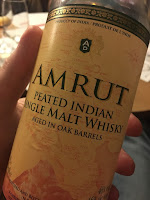 |
| The line-up. |
It was a busier-than-usual Manchester Whisky Club crowd which gathered upstairs at The Briton's Protection this month, for our semi-regular Old and Rare evening. Committee member Martin had
picked out five unusual and hard-to-find drams for us to knock into, many sources from online auctions, and there were certainly some interesting stories behind the whiskies in the line-up.
 |
| Dram 1: Shackleton Journey |
None was more interesting than the opening drink, the 47.3% Mackinlay's Shackleton Journey Edition. It's a recreation of the whisky taken by polar explorer Ernest Shackleton on his 1907 expedition to Antarctica, cases of which were discovered more or less in tact a century later.
The Mackinlay's brand is owned by Whyte & Mackay, and it's they who analysed three of the original bottles before putting together the new blend although, as before, the main component is whisky from the Glen Mhor distillery in Inverness.
 |
| Dram 2: 18yo Tomintoul |
Unfortunately, the story behind the whisky proved to be rather more appealing than the whisky itself. Most seemed to think it was ok as far as it went, but not worth the RRP of £110. Looking on the bright side, one member commented that it was the sort of whisky "you'd expect to taste like absolute arse, but it doesn't". So there's that.
Up next was an 18-year-old Tomintoul, a 40% bottled in 1985, back in the days when it was still branded as a 'Tomintoul-Glenlivet'. The bottling was done by an independent that no longer exists, ABC of Dundalk in Ireland, which was mainly known for bottling Guinness as well as soft drinks, which could help explain the unusual screw top on this particular bottle.
 |
| Dram 3: 20yo J&B |
This one certainly had an unusual taste, but it was disappointingly flat for an 18yo. It did improve with a bit of water, and there seemed to be a hint of sherry in there, although some suggested that given the nature of ABC's other work it might have been matured in Vimto casks. Another one to pass on if you see it for sale anywhere.
The evening picked up considerably with the third dram, a 20yo J&B at 43%. Again the branding gave away the age, as it was produced during the days when J&B was still known as Justerini & Brooks, a company with roots going back to 1749.
Little information was available about this bottling so Martin got in touch with J&B's present day owners, Diageo, to see if they could shed any light on it. According to the archive team there, the bottle we had was probably produced in 1969 and contained Knockando single malt, a precursor to the early 1970s when bottlings under the Knockando name began to be released. They added that they had no tasting notes and had never heard of anyone who had drunk it, so were keen to find out what we thought!
 |
| Dram 4: 23yo Imperial |
This won lots of plaudits. It's recognisably a Speyside whisky, but a Speyside from another era, as befits whisky which would have been produced in the late 1940s. There were muted sherry notes, potentially a legacy of having to re-use sherry casks from before the war.
After our mid-evening break, another rarity came our way with a 23yo Imperial, bottled by Mackillops. There won't be too many more of these available, as the Imperial distillery (another Speyside) was mothballed in 1998 and demolished three years ago. This particular one was bottled in 2014 and was 58.4%.
 |
| Dram 5: 20yo Laphroaig |
Again, this went down well, with enthusiastic comments ranging from "a nice drop" to "very good" and even a "superb" or two. Some members thought it went well with a bit of water, but it was perfectly fine as a cask strength whisky as well: "if it ain't broke, don't fix it" as someone said.
Martin saved the best for last though, with an interesting and unusual bottle of a club favourite, Laphroaig. He queued up at a recent show to get his hands on one of just 516 bottles of The Whisky Exchange's latest Masterpiece bottling, a 20yo Laphroaig which spent its full maturation in Pedro Ximinez casks.
To say that this gave the whisky a few sherry notes would be quite the understatement. In fact, it looked browner than some of the glasses of real ale dotted around the room.
 |
| The dram of the night voting. |
On the nose and then on the palate, the big question was: "Where's the peat gone?" It was still there, but was largely masked by the sweetness of the PX, and it was more of a smoky flavour which remained prominent. "An exceptional drink" and "a bit of class" were sentiments which propelled this to a virtually unanimous triumph in the dram of the night voting.
So, the end of another successful tasting, and it was one of the busiest ever with an excellent turnout of members old and new. Thanks in particular go to Martin for taking the time and effort to source such an interesting selection of whiskies for us, and of course to everyone at the Briton's Protection for hosting us well as always.
And on the day it was sadly announced that Vine is to close, here's the line-up of whiskies in, what else, but a Vine!



















































